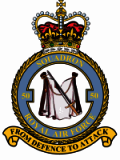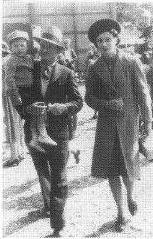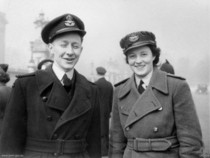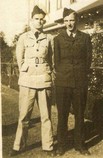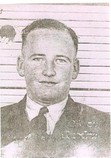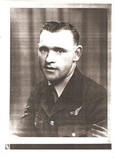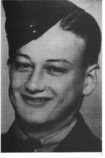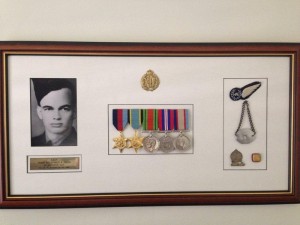Sergeant Stanley Alfred Gregg
404420 Sgt. Stanley Alfred Gregg RAAF. 50 Sqn. RAF.
8/9/1919 ------ 24/10/1942
Stan was born in Brisbane, Queensland, Australia on the 8/9/1919, the eldest in a family of nine children. At 20 years of age he enlisted and volunteered for active service in the Royal Australian Air Force and soon after, on the 16/8/1940 was on his way by interstate train to No.2 ITS at Bradfield Park near Sydney in NSW, 500 miles away. He was selected for flying training and spent the next couple of months training as a Wireless Operator/Air Gunner (WO/AG) and at completion of this basic training boarded the ship RMMS Aorangi, travelling via New Zealand to pickup more recruits and then continuing on to Canada to become trainees in the Empire Air Training Scheme known as (EATS). In one of his letters to Mum and Dad, Stan spoke of the antics which took place on one of the Fijian Islands in the Pacific where they anchored for a few days to gather supplies. Stan and a few others took the native boys fishing a few times over a couple of days using hand grenades and acquired heaps of fish for the village, the local hospital and of course the ship and in return received many bunches of bananas and other fresh fruit collected by the village women, while the men sat around smoking. When the fish were being gutted and cleaned and the boys thought no one was watching they would toss some into the bushes to be collected later on. The Aorangi stopped at Honolulu but was not allowed to stop at America due to the USA not yet being at war and went direct to Canada where the troops boarded a train and travelled through the Rocky Mountains to Calgary where 5 months of training began at NO.2 wireless school. Stan was able to handle Morse Code quite well and topped a class of 175 due to having a good understanding of it before he enlisted. He then went to Mossbank to do Gunnery and Bombing training for 7 weeks and then to 1M Depot at Debert for practical flying training where he passed with 95% for accuracy.
On the 19 May 1941 Stan left Canada and sailed across the Atlantic bound for England as a Sergeant WO/AG. Not long after arriving in England Stan was told that 6 of the chaps who gave up wireless training in Canada to become straight gunners had already been killed as well as 4 of the New Zealanders. After arriving in the UK Stan went to 1 Signals School at Cranwell on the 1st. July 1941 and on the 14th. Oct. 1941 for his final training in the UK before being posted to a Squadron. He went to 14 OTU Cottesmore where I believe he trained as Bomb Aimer.
Stan was involved in 3 crashes during training which he has spoken about in his letters.
Since the last time I wrote Mum I have had quite an adventurous time, I have been in two crashes but managed to get out of them without serious injury, in the first crash I hurt my legs a bit and was taken off flying duties for one week and in the second crash I came out of it with hardly a scratch, anyhow Mum I have been flying again now for a few weeks and so far everything seems to be going ok again, after the first crash I had to lie in bed for a couple of days as both my legs were hurt a bit and I couldn’t walk for about four days, my back was bruised a bit and my hands were cut slightly and I had a bump on my head, it was bad weather that caused us to crash the first time, we had just come home from a long flight and the pilot was doing very steep turns in order to keep in sight of the aerodrome, the clouds were only 300 ft. Off the ground and we could only see through the mist for 150 yards. We were flying over the drome when suddenly we flew into a cloud bank that was touching the ground and so the pilot tried to turn sharply to keep the drome in sight then suddenly the plane got out of control and started to do what we call a flat spin at the same time losing height, we were only up about 200 feet when this started to happen and there seemed to be no chance of getting out of the dive, I realised we were going to crash so I grabbed the handles of my guns tightly and got prepared the best I could to take the terrific bumps which I expected to come, then due to some miracle the pilot managed to get the plane straight and level again when we were only about five feet off the ground but it was too late for we hit a fence then hit the ground on our belly doing about 150 miles per hour then I remember we got a couple of terrific bumps as we skidded along the ground, as we bumped along I got tossed from one side of the plane to the other hitting everything in my way then we hit a ridge in the ground about 2 feet high and I remember the floor crumpled up and got ripped to pieces under me, then as the floor disappeared my legs dropped to the ground as we skidded along still doing about 100 miles per hour, when my legs dropped to the ground I felt them get dragged underneath the plane and were mixed up with the wreckage that was once the floor that I stood on, here I felt them get bumped in about a dozen places but couldn’t get them free, I honestly expected them to be broken before we came to a standstill, then I felt the plane stop and I was amazed to know that I wasn’t seriously hurt and my legs were still ok from the bumps they got, the flying boot on my right foot got torn off during the crash and my left foot was twisted around sideways and jammed in the wreckage which was once the seat that I sat on, the navigator had to help me get clear from the wreckage then we both raced away to where the rest of the crew were standing in case the petrol tanks burst into flames and set the thing on fire, by this time several people had come to the rescue, some in cars and trucks that were on the aerodrome, the fire engine arrived and put an end to the stream of smoke that was rising from our port engine, then the ambulance came but fortunately there were no casualties for them to rush back to hospital, everyone of the crew escaped with only minor injuries but the ambulance took us to hospital to dress our small wounds. Just before we left the scene of the crash I took a short walk back along the wreckage to find my parachute and flying boot which had fallen through the floor when it was being torn away and it was then that I noticed how lucky we really were, just before we hit the ground we missed a row of trees with what must have been only a few feet, then went through a fence and across a field about 100 yards wide then through another fence then through the barb wire entanglement and finally came to rest about 200 feet inside our aerodrome boundary, from where we hit the ground to where we came to rest was a trail of wreckage and a furrow dug into the ground about 1 foot deep and 4 feet wide, about halfway along the propellers were torn from the engines and lay twisted up like a couple of spiders. After I had rested for about a week my legs felt a lot better and I was walking around almost normal again except for a slight bit of stiffness in both thighs but the M.O. said that I would be ok for flying duties again so for the next few days I got a couple more flying hours time in again then on Thursday night last I was due to go off on a night flight which would have taken about 4 ½ hours to do , we took off at 7 o’clock and after we had been flying along steady for about ¾ of an hour our starboard propeller fell off in the air and fell to the ground shortly after we had passed over the fairly large town of York, then the engine burst into flames and caused the exhaust pipe to become red hot and melt from its mountings and fall to earth also, like a rocket leaving a trail of sparks behind it as it fell, the engine was on fire for a few minutes leaving sheets of flame about 10 feet long fly back beneath the wing licking the wheel of our starboard under carriage and passing beneath the fabric covering of the flaps on the wing. Finally the pilot cut the engine leaving the fire to go out as the engine stopped working, but this also meant that we had to try to get home on one engine which gave us only enough flying speed to just keep us in the air, twice on the way home we got into a spin and lost a few hundred feet before we got out of them again, the pilot warned us to have our parachutes ready to jump in case anything happened suddenly but I doubt if we would have had much of a chance because we were only about 800 feet up and if we had got into a spin or dive we would have lost about 500 feet or more before we could have got clear of the plane, when we were nearing home a search light picked us up and held us in its beam for a few minutes until the pilot fired his very pistol which identified us as a friendly plane, when we only had about ¼ hour left to go before reaching our home base our pilot told us that the good engine was becoming overheated from the stress of doing the work of two engines and he couldn’t take us any higher up to do a safe parachute jump, a few miles ahead of us the pilot noticed a flare path of another drome who were also doing night flying, so our pilot decided to make a crash landing on this drome alongside the flare path so we all got into the safest positions, mine was near the De Spar. These bombers have no windows so I held on tight and waited for the bump. We hit the ground with a terrific bump and bounced into the air again about 5 feet high bouncing and skidding and rocking along the ground, the nose had crumpled from the first hit and as we skidded along snow mud and grass shot up inside the plane and covered us as we ploughed along until it stopped and then we all jumped out and ran for our lives in case it caught fire, the only injury was when one of the crew jumped out and cut his finger on some ice. We were given a meal in the Sergeants mess and a bed for the night and in the morning went out to check the old wreck in the middle of the drome, stayed at this drome for the day and were then flown back to our home base
6//7/42 Sections of a letter........... Dear Mum and Dad, since the last time I wrote to you I have had a bit more excitement with one more crash landing and also doing my second operational raid over Germany. The night that we crashed we were flying on a cross country trip and got iced up while trying to climb up through a storm to get above the cloud which was 12000 feet, we weren’t issued with oxygen masks so we decided to return as we were icing up and the wind gusts were up to 80 miles an hour and it was quite bumpy, after flying on the return journey for an hour our Navigator decided that we must be somewhere over our home base. The pilot said that due to the low cloud cover he would fly around for a bit and search for a break in the clouds. When we got down to 7000 feet the ice was so thick all over our plane we expected it to dive or spin out of control. At 5000 feet the pilot gave orders to open the escape hatch and put on our parachutes and prepare to bale out, as we were all sitting around the escape hatch I remember thinking to myself ,well I don’t fancy the idea of having to jump out into that horrible darkness. The wing and tail controls became completely locked with ice and we weren’t equipped with de-icing equipment, at 3000 feet we found ourselves at the bottom of the cloud and in the middle of a heavy rain storm the ice was melting and breaking away and at 1500 feet she was quite controllable again. When everything seemed to be under control again we began searching for our home base which was difficult in the rain and mist, eventually we found it with the help of beacons. (3 lines in the original letter were cut out by the censor, maybe too much was said about the beacons.) On the first 2 attempts to land we overshot the aerodrome due to poor visibility on the third attempt we were still slightly high but the pilot tried to force the plane down onto the end of the flare path in a fairly steep glide, we hit the ground too hard and bounced about 30 feet into the air, when we touched down again our port undercarriage collapsed and the plane fell down on one side, the port wingtip dug into the ground and sent us spinning in wild circles. Well Mum I have been on my second raid now, it was that big one to Cologne when more than 1000 bombers took part ......................................................................
19/20 May 1942. Aircraft: Manchester L 7475 Attacked Mannheim, Dep. 2215 Ret. 0444 duration 6 hours 29 minutes. This was Stans 1st. raid, his pilot was 20 year old P/O Leslie Manser who was killed 11 days later on the 1000 Bomber Raid on Cologne and was awarded the Victoria Cross posthumously. Crew, Manser, Gregg, Barnes, Keauffling, Horsley, King, Penfold.
30/31 May 1942. Aircraft: Manchester L 7419 attacked Cologne (1000 Bomber Raid )
Dep. 2325 Ret. 0503 Duration 5 hours 38 minutes ( bomb doors damaged by flak )
Crew. Sgt. Dampier-Crossley, Eyres, Gregg, McKerrow, Bohn, West, Sale.
P/O Dampier-Crossly was later KIA on 11th August 1943.
10th. August 1942 Posted to 50 Conversion Flight.
Sgt.Eyres, M H Rawlins, Gregg, Bohn, T McKerrow, C R Poole. ...........................................................................................................
30th August 1942 Posted from 50 Conversion Flight.
Sgt. Eyres, M H Rawlins, Gregg, Bohn, T McKerrow, C R Poole. (Upgrading from Manchesters to Lancasters)
1/2 September 1942. Aircraft: Lancaster W 4135 attacked Saarbrucken Dep. 2355 Ret.0531 Duration 5 hours 36 minutes (small hole in starboard tail (Flak Damage) Crew Sgt. Eyres, Gregg, McKerrow, Rawlins, Bohn, Poole, Kemp.
2/3 September 1942. Aircraft: Lancaster R 5689 “N” Attacked Karlsruhe Dep. 2326 Ret. 0517 Duration 5 Hours 51 Minutes. Crew Sgt. Eyres, Gregg, McKerrow, Rawlins, Bohn, Poole, Penfold.
4/5 September 1942. Aircraft: Lancaster W 4135
Dep. Cancelled due faulty oil pressure.
8/9 September 1942. Aircraft: Lancaster W 4155 Attacked Frankfurt Dep. 2101 Ret. 0257 Duration 5 Hours 56 Minutes. Crew, Sgt. Eyres, Gregg, McKerrow, Rawlins, Bohn, Poole, Haywood. Bombs dropped on railway lines due to both Starboard engines cutting out at 17000 feet.
10/11 September 1942. Aircraft: Lancaster R 5685 “P” Attacked Dusseldorf Dep. 2029 Ret. 0107 Duration 4 Hours 38 Minutes. Crew, Sgt. Eyres, Gregg, McKerrow, Rawlins, Bohn, Poole, Haywood.
13/14 September 1942. Aircraft: Lancaster R 5685 “P” Attacked Bremen Dep. 2312 Ret. 0413 Duration 4 Hours 1 Minute. Crew, Sgt Eyres, Gregg, McKerrow, Bohn, Poole, Haywood, Wardell.
14/15 September 1942. Aircraft: Lancaster R5685 “P” Attacked Wilhelmshaven Dep. 2008 Ret. 0018 Duration 4 hours 10 minutes. Crew, Sgt. Eyres, Gregg, McKerrow, Bohn, Poole, Haywood, Wardell.
18/19 September 1942. Aircraft: Lancaster R5685 “P” “Gardening” Quince area Vegetables planted from a height of 600 feet Parachutes opened . Dep. 1913 Ret. 0137 Duration 6 hours 24 Min. Crew, Sgt. Eyres, Gregg, McKerrow, Bohn, Haywood, Wardell, Parker.
19th. September 1942 Pilot. Sgt Ron Eyres Posted to SEQ Swinderbury NE sick.
Thanks to the internet and 50/61 Sqn. Assn. Site, Mrs. Eileen Eyres wife of Stans pilot Ron Eyres saw my request in 2009 attempting to make contact with crew members or their families and thanks to Mrs. Eyres in the UK, I had the answer as to why this crew was disbanded when she told me her husband had ruptured an ear drum and became an instructor for the duration of the war, I was also forwarded photocopies from Ron Eyres Log Book with entries relating to my brothers operations with his crew. This was information that I had wished for but never expected to receive, especially after so many years had passed. In fact it was 67 years later. Eileen Eyres and I now keep in contact by letters and Christmas Cards.
Stan now crewed up with Russell Cumberland’s crew made up of three Aussies and four English and did four Operations.
5/6 October 1942. Aircraft: Lancaster R 5747 “G” Attacked Aachen Dep. 1946 Ret. 0045 Duration 5 Hours 45 Minutes. Crew, Russell Cumberland Pilot, James Philpot Navigator, Stanley Gregg Bomb Aimer, Walter Scott F/E, John Glendinning WO/AG, Frank Adey Rear Gunner, John St. Bernard Fern, Mid Upp. Gunner.
6/7 October 1942. Aircraft: Lancaster R 5747 “G” Attacked Osnabrook Dep. 1938 Ret. 0004 Duration 4 Hours 26 Minutes. Crew, Cumberland, Philpot, Gregg, Scott, Glendinning, Adey, Fern.
22/23 October 1942. Aircraft: Lancaster W4131 Attacked Genoa Dep. 1725 Ret. 0050 Duration 7 hours 25 minutes. Crew, Cumberland, Philpot, Gregg, Scott, Glendinning, Adey, Fern. Unfortunately on the way out to the target, the outer port engine cut out at 1945 hours, ten minutes later burst into flames. Made the return journey on 3 engines and landed at Waddington owing to bad visibility at base.
24 October 1942. Aircraft: Lancaster R 5691 “K” Attacked Milan Dep. 1232 Did not return from the Milan Raid and official records state that Lancaster R5691 VN K crashed into the channel. The bodies of pilot Russell Cumberland and navigator Jim Philpot, were washed ashore on the same evening of the crash then John Glendinning. The body of rear gunner Frank Adey was found in the channel some days later near Le Harve, all four are buried in France. The bodies of mid upper gunner John St. Bernard Fern, flight engineer Walter Scott and bomb aimer Stanley Gregg were never found and are commemorated at the Runnymede Memorial. Stan is also commemorated at the Australian War Memorial in Canberra.
These are the planes Stan served on and what eventually happened to them
Manchester L 7475 lost on 16 Aug.1942
Manchester L7419 Served with 207; 50; 408 Sqns. 1654 Cu. Comp. service at no. 4 Gunnery School
Lancaster R 5689 Lost on 19 Sept.1942 138 Hours
Lancaster R 5691 Lost on 24 Oct. 1942
Lancaster W 4155 Lost on 17 Dec. 1942
Lancaster W 4135 Lost on 28 Jan. 1943
Lancaster R 5747 Crashed on 21 July 1943 became 4371 M
Lancaster R 5685 Lost on 30 Sept.1943 316 Hours
Lancaster W 4161 Became 4451 M 587 Hours 75 Ops.
From the Records Stan flew with the following personnel.
Leslie Manser (VC) K.I.A. 30/31 May 1942 RAF. Awarded the Victoria Cross.
S.H. Parker K.I.A. 12/13 October 1942
M.H. Rawlins K.I.A. 12/13 October 1942 RAF.
Terry McKerrow P.O.W. 12/13 October 1942
Russell Cumberland K.I.A. 24 October 1942 RAAF. from Goulburn NSW
James T Philpot K.I.A. 24 October 1942 RAAF. from Lithgow NSW
Frank Adey K.I.A. 24 October 1942 RAF.
Walter Scott K.I.A. 24 October 1942 RAF.
James St. Bernard Fern K.I.A. 24 October 1942 RAF.
John Glendinning K.I.A. 24 October 1942 RAF.
H.R. Barnes K.I.A. 16/17 April 1943 ?
S.J. King K.I.A. 9/10 July 1943 RAAF
Edward Dampier- Crossley K.I.A. 11 August 1943 RAAF
Keauffling ? ?
Horsley ? ?
Penfold ? ?
N Bohn ? RAF
West ? ?
Sale ? ?
J Kemp ? ?
J.L. Haywood ? ?
Ronal Eyres Passed away 1999 RAF
Some time ago during Gordon Browns time as PM, I contacted the British Government asking if this aircraft could be found due to its obvious close proximity to the French coast and was told pretty bluntly that the 3 missing bodies were probably washed out to sea and that no further action would be taken to locate Lancaster R5691 VN K. This aircraft took off at 12.32 and according to P/O Rowlings reference from his diary it was about a 10 hour “twitch.” Being damaged over Milan and limping back I believe the aircraft would have crashed into the channel around 11pm or later, the official records state that 2 bodies were washed ashore on the same date, the 24th. October 1942, therefore, my belief is this Lancaster must be close to the French coast. Just recently a “Dornier” has been retrieved from the edge of the English Channel. I realise that other crew members families in England would have to be considered but Stanleys 7 remaining brothers and sisters in Australia are all in agreement.
After seeing his brother Stan off at the South Brisbane Station, 18 year old Ron went straight to the recruiting office in Brisbane and enlisted in the Royal Australian Navy, he was assigned to a destroyer of Scrap Iron Flotilla fame the HMAS Vampire which was the first Australian ship to engage the Japanese Navy in battle when it was one of the escorting destroyers to the Royal Navy’s, Prince of Wales and Repulse when they were sunk by Japanese Zeros, 3 days after Pearl Harbour was attacked in 1941. After sinking one Jap destroyer and damaging another a few months later, the Vampire was bombed, broken in half and sunk, Ron spent 8 hours in the water before being rescued by the Hospital Ship Vita, and spent the rest of the Pacific War on HMAS Australia and the Fairmile ML820
Stanley was born in 1919, eldest in our family of 9 children and was KIA in 1942. I was born in 1937 the youngest of the 9 children and as a 5 year old in 1943 I told my teacher my brother was killed in the war. She said to me. Go and sit down you stupid little boy your Brother was not killed in the war. She probably couldn’t think past a couple of years difference in the age of family members.
I am indebted to the youngest of these children, Ray Gregg for providing this story and it has been a pleasure in entering it on this web site. A family to be proud of.
Mike Connock


